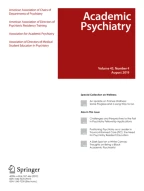Abstract
Objective
The authors evaluate an Internet virtual reality technology as an education tool about the hallucinations of psychosis.
Method
This is a pilot project using Second Life, an Internet-based virtual reality system in which a virtual reality environment was constructed to simulate the auditory and visual hallucinations of two patients with schizophrenia. Eight hundred sixty-three self-referred users took a self-guided tour.
Results
Five hundred seventy-nine (69%) of the users who toured the environment completed a survey. Of the survey responders, 440 (76%) thought the environment improved their understanding of auditory hallucinations 69% thought it improved their understanding of visual hallucinations, and 82% said they would recommend the environment to a friend.
Conclusions
Computer simulations of the perceptual phenomena of psychiatric illness are feasible with existing personal computer technology. Integration of the evaluation survey into the environment itself was possible. The use of Internet-connected graphics environments holds promise for public education about mental illness.
Similar content being viewed by others
References
Hoffman HG: Virtual-reality therapy. Sci Am 2004; 291: 58–65
Zajtchuk R, Satava RM: Medical application of virtual reality. Comm ACM 2004; 40: 63–65
Waterworth JA: Virtual reality in medicine: a survey of the state of the art. http://www.informatik.umu.se/~jwworth/medpage.html. Accessed October 5, 2005
Hodges L, Anderson P, Burdea G, et al: Treating psychological and physical disorders with VR. IEEE Comput Graph Appl 2001:25-33
UMEA University VR Lab: Empathy as evoked by virtual reality technology progress report: Phase 1, unpublished Tech. Rep. number. 1999
Piron L, Tonin P, Trivello E, et al: Motor tele-rehabilitation in post-stroke patients. Med Inform Internet Med 2004; 29: 119–125
Rizzo AA, Strickland D, Bouchard S: The challenge of using virtual reality in telerehabilitation. Telemed J E Health 2004; 10: 184–195
Hoffman HG, Richards TL, Bills AR, et al: Using fMRI to study the neural correlates of virtual reality analgesia. CNS Spectr 2006; 11: 45–51
Rothbaum BO: Virtual reality in the treatment of psychiatric disorders. CNS Spectr 2006; 11: 876
Caruso JB: Key Findings:: ECAR Study of Students and Information Technology: Convenience, Connection and Control 2004. http://www.educause.edu/ir/library/pdf/ecar_so/ers/ers0405/Ekf0405.pdf. Accessed October 5, 2005
Kaplan and Sadock’s Comprehensive Textbook of Psychiatry, 7th ed. Edited by Sadock BJ, Sadock VA. Baltimore, Md, Lippincott, Williams & Wilkins, 2000, pp 1169–99
Banks J, Ericksson G, Burrage K, et al: Constructing the hallucinations of psychosis in virtual reality. J Network Computer App 2003; 27: 1–11
Banks J, Tichon J, Ericksson G, et al: A virtual environment to simulate the experience of psychosis. Proceedings of the VIIth Digital Image Computing, 2003
Silberner J: The sights and sounds of schizophrenia. http://www.npr.org/programs/atc/features/2002/aug/schizophrenia. Accessed October 5, 2005
There.com. http://www.there.com. Accessed October 5, 2005
Active Worlds: 3D Chat, Virtual Reality Building Platform. http://www.activeworlds.com. Accessed October 5, 2005
The Gaming Open Market, Second Life L$ Market. http://www.gamingopenmarket.com/market.php?symbol=SLL. Accessed October 5, 2005
Au WJ: A lever to move the mind. http://secondlife.blogs.com/nwn/2004/09/in_the_minds_ey.html. Accessed October 5, 2005
Doctorow C: Virtual schizophrenia comes to Second Life. http://www.boingboing.net/2004/09/10/virtual_schizophreni.html. Accessed October 5, 2005
Thompson C: Virtual schizophrenia. http://www.collisiondetection.net/mt/archives/000971.html. Accessed October 5, 2005
Letterie GS: How virtual reality may enhance training in obstetrics and gynecology. Am J Obstet Gynecol 2002; 187: S37–40
Baram Y, Miller A: Virtual reality cues for improvement of gait in patients with multiple sclerosis. Neurology 2006; 66: 178–181
Tuggy ML: Virtual reality flexible sigmoidoscopy simulator training: impact on resident performance. J Am Board Fam Pract 1998; 11: 426–433
Author information
Authors and Affiliations
Corresponding author
Rights and permissions
About this article
Cite this article
Yellowlees, P.M., Cook, J.N. Education About Hallucinations Using an Internet Virtual Reality System: A Qualitative Survey. Acad Psychiatry 30, 534–539 (2006). https://doi.org/10.1176/appi.ap.30.6.534
Received:
Revised:
Accepted:
Published:
Issue Date:
DOI: https://doi.org/10.1176/appi.ap.30.6.534
